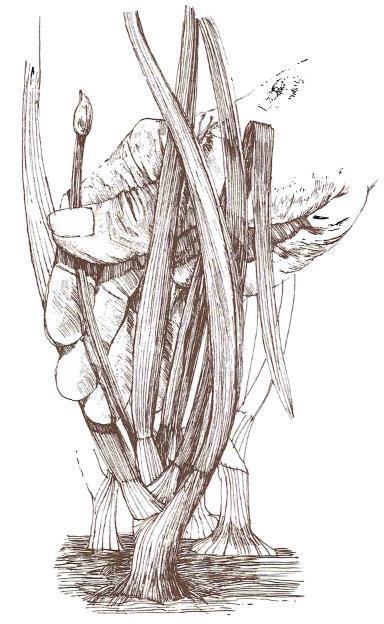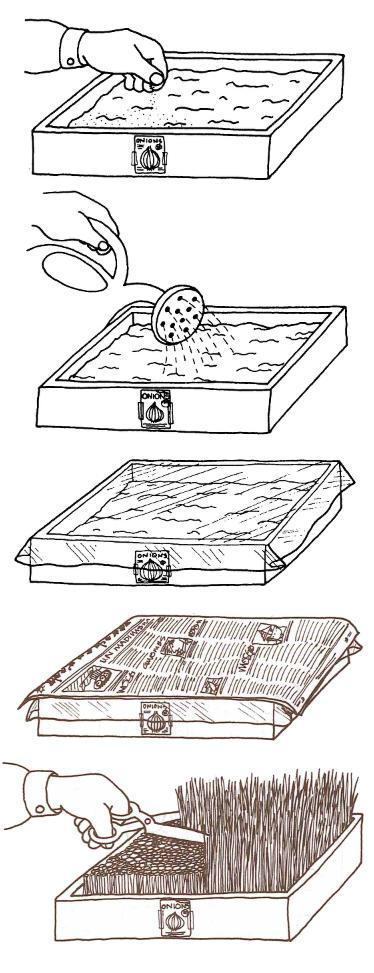As with most vegetables, you can start onions from seed in the garden. But many onions have relatively long growing seasons and onion seeds don't germinate quickly, so it's often better to start the crop another way. You can set out transplants, or you can plant "sets" which are simply half-grown onions.
Where Sets Come FromMany sets are grown from seed on big farms near Chicago. The onion seeds are planted very thickly. Super-crowding of the plants makes the competition for water and fertilizer fairly stiff, so the plants never get very big and the resulting bulbs are quite small.
The small onions are harvested in the late summer or fall and dried for a month or more to rid them of moisture that could cause rot. Then the sets are stored until gardeners need them the following spring.
It's said that Chicago got its name from onions. Indians, who once lived nearby, called the place "Shikako" which means "Skunk Place" after the strong smell of wild garlic, onions, and leeks that once flourished there.
 Buying Sets
Buying SetsIn the North you'll find the first onion sets of the year at garden centers when there's still snow on the ground.
Using sets is probably the most popular, convenient, and dependable way to get onions started. They're very easy to plant, and you can harvest your first eating onions sooner than if you started from seeds.
Stores usually sell only a few varieties of sets, such as long-keeping white and yellow varieties and a red type or two. You can also grow sets yourself during one season for use the next year.
Sets are sold by the pound or by the scoop; each set is one onion. When you buy onion sets, watch the size. Sets that are smaller than 1/2 inch in diameter take longer to grow, but they'll still produce. Sets larger than 3/4 inch in diameter are very apt to "bolt" or grow seed pods in a hurry after you plant them. If you let them grow seed pods (a pod looks like a miniature version of the domes on the towers of the Kremlin in Moscow), the plants put energy into the seeds and not into the bulb. The bulbs will be small, tough and won't keep, so pick the pods or seed stalks off as soon as you see them.
The most dependable sets are the size of marbles -- 1/2 to 3/4 inch in diameter -- and are quite firm.
Growing Your Own SetsTo save some money and have a little onion fun, you may want to grow your own sets. Here's how to do it: In July in the North, or August farther south, create a small section of your garden to plant a good storage onion such as 'Yellow Globe'. Sow the seeds about 1/4 inch apart in one-foot-wide rows. Give the plants some fertilizer and just let them grow without thinning them at all.
Shortly before the first frost, bend the tops over. Wait a week or so and then dig the small bulbs out of the ground. After curing them for a few weeks, store them in mesh bags in a very cool (40° F) dry, dark place. The following spring you'll have plenty of sets on hand.
Most southern gardeners don't bother with growing sets because they have a pretty long season and don't always need the head start that sets give. If you like to experiment, here is one method that works pretty well in the South; select a short-day onion seed variety that's a good keeper and in early March sow it thickly in a wide row and leave the onions to grow. As they'll be very crowded, the bulbs won't get oversized. Harvest the bulbs when the tops wither from the hot summer sun. Dry them in the sun for a day or so and store them in mesh bags in a very cool, dry place. In the fall you can set them out in the garden again. They'll put on a little root growth before it gets cold and when the weather warms up in the spring, they'll pop back to life giving you very early onions. Of course in the deep South, where the winters are quite often mild, you can plant sets in the fall and harvest onions throughout the winter.
Buying TransplantsThe best way to start big-bulb, European-type onions is from transplants. These are thin, young onion seedlings, and the optimum planting size is when they're just the size of a pencil. You can send away to seed or plant companies for bunches of transplants, or you can sometimes buy them at your local nursery. To get mail-order transplants, order the varieties you want sometime during the winter from companies in southern states; they'll ship them to you in the spring. You have to order by the bunch (75 to 100 plants in each bunch). As with many other things, it'll be cheaper if you order in quantity, so getting together with friends on a big order can save you a little money.
Taking Care of Mail-Order or Nursery PlantsThe first thing to do when the plants arrive is to unwrap them. The onion plants develop a lot of heat when banded together, and heat encourages rot in onions. Next, put 1/2 inch of water in a shallow baking pan, and stick the roots in the water just enough to get their "toes" wet. They'll revive quickly. Plant your onions as soon as you can after receiving them. If you can't plant them within a few days, forget the bath. Put the unwrapped plants in plastic bags and store them in a cool, dry place until you can plant. The refrigerator is a good spot!
You can also "heel in" your transplants until you have time to plant them where they belong in the garden. Just dig a shallow trench out in the garden (or use a container), set the plants a couple of inches deep and firm the soil tightly around them. Soil in the spring is usually wet enough to keep the roots from drying out.
If any plants have a bad odor or are slimy or slick, they're probably rotting. Separate them from the others right away and throw them out. They won't make it in the garden.
Growing Your Own Transplants
There's a tremendous satisfaction in growing your own plants indoors for transplanting. For one thing you have the benefit of choosing from more varieties.
Buy your seeds early enough to start your plants anywhere from 8 to 16 weeks before the last hard frost in your area. Start the seeds in a 4-to 5-inch deep flat filled with very rich, sterile, loose soil. Sterile soil is free of weed seeds and harmful disease organisms, so the onion seeds have a better chance at the start. The various potting soil and starter mixes on the market are good, but mixing in extra fertilizer before you plant is a must. One or two tablespoons of 5-10-10 fertilizer added to every gallon of potting soil works fine for onions and other vegetables.
Sprinkle the seeds into the soil and gently press them into the soil. Try to space the seeds about 1/4 inch apart, but don't fuss about it. It's impossible to get them spaced exactly right, and you can always thin them if they get too close. After sowing, just barely cover the seed with a little more soil or sand and tamp it down. Next, moisten the soil and cover the flat with a sheet of plastic and then some newspaper. The plastic creates a greenhouse effect retaining the moisture, and the newspaper keeps the temperature even. (Onion seeds don't need light to germinate.) You won't need to water again until you take off the newspaper or plastic.
Put the flats in a nice, warm spot around 65o or 70o F if possible. (Don't worry too much about the temperature being exactly right. Onion seeds will germinate anywhere from 40° to 80o F; they simply prefer a steady 65o to 70oF.)
Don't put the flats on a window sill before the seedlings come up. The temperature there fluctuates too much: On a sunny day it can rise to 90o F or more, but at night it can be the coldest place in the house. That's not good for germination; onions need an even temperature.
When the seedlings sprout, remove the plastic and newspaper and put the flats by a window or under lights. They won't need too much attention. Just make sure they get enough water, and you should add a little fertilizer from time to time -- about a teaspoon in water every two weeks is good. Pour it around the edges of the flat so that the water spreads across the whole area.
In a few weeks, you'll notice the tiny plants getting tall and spindly. That can be a problem, unless you turn it into a plus. It's very important that your onion seedlings not fall over and get too skinny to transplant, so when they're three inches tall, cut them back to one inch. This is your first harvest! The trimmings are delicious in dips, salads, sandwiches or as a garnish. After you cut them, the plants will naturally produce more tops. When the tops reach three inches again, mow them back to one inch. As long as the plants are indoors, cut them back whenever they grow to three inches. With short tops the plants can put more energy into developing healthy roots, and that will help them get a good start when you put them in the ground. A few weeks before planting, stop trimming them. Top growth will be important outside.
 Victory Seed Company has all the seeds you want for your best garden in 2024.
Victory Seed Company has all the seeds you want for your best garden in 2024.
For 25 years, the family-owned Victory Seed Company has provided the highest quality vegetable, herb and flower seeds to families across the country. We are passionate about providing you the best seeds available that give excellent germination, robust plants, and the harvest you want. With a catalog of over a thousand varieties, we have everything, and our prices are the kinds that we'd want to pay. We have hundreds of yesterday's heirloom vegetables, as well as today's award winning hybrid selections. Get to know us by visiting our website and browsing through our online vegetable seed catalog.
| 1. Growing Onions ← you're on this article right now |
| 2. Watering Onions |
| 3. Onion Problems |
| 1. Growing Onions ← you're on this article right now |
| 2. Watering Onions |
| 3. Onion Problems |